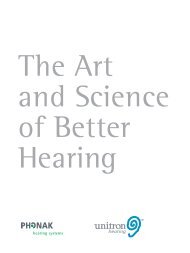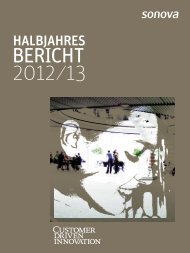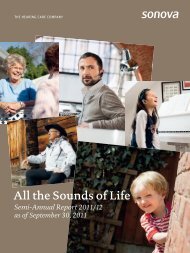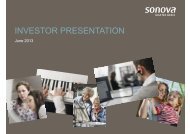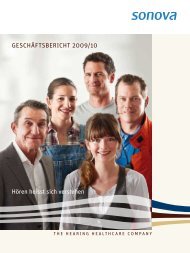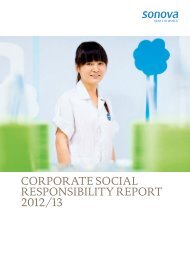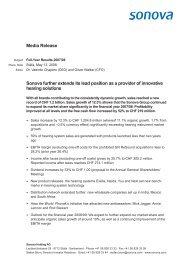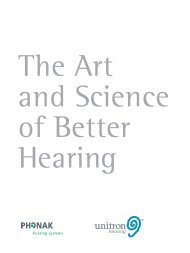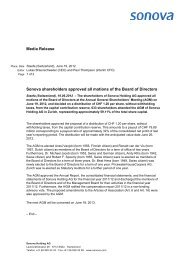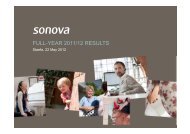Annual Report 2005/06 THE WORLD OF SOUND - Sonova
Annual Report 2005/06 THE WORLD OF SOUND - Sonova
Annual Report 2005/06 THE WORLD OF SOUND - Sonova
You also want an ePaper? Increase the reach of your titles
YUMPU automatically turns print PDFs into web optimized ePapers that Google loves.
price variances are analyzed and credited or charged to inventoryif not related to abnormal amounts of wasted materials,labor or other production costs. Net realizable value is theestimated selling price in the ordinary course of business less theestimated costs of completion and selling expenses.Manufactured finished goods and work-in-process are valuedat the lower of production cost or net realizable value. Provisionsare established for slow-moving, obsolete and phase-outinventory.Tangible assetsTangible assets (land, buildings, plant and equipment) arevalued at purchase or manufacturing cost less accumulateddepreciation and any impairment in value. Depreciation is calculatedon a straight-line basis over the expected useful livesof the individual assets or asset categories. Where an assetcomprises several parts with different useful lives, each partof the asset is depreciated separately over its applicable usefullife. The applicable useful lives are 25–40 years for buildings,and 3–10 years for production facilities, machinery, equipmentand vehicles. Land is not depreciated. Leasehold improvementsare depreciated over the shorter of useful life or lease term.Borrowing costs incurred for the construction of any qualifyingasset are capitalized during the period of time that is requiredto complete and prepare the asset for its intended use. Subsequentexpenditure on an item of tangible assets is capitalizedat cost only when it is probable that future economic benefitsassociated with the item will flow to the Group and the cost ofthe item can be measured reliably. Expenditures for repair andmaintenance which do not increase the estimated useful lives ofthe related assets are recognized as an expense in the periodin which they are incurred.Research and developmentThe majority of research and development costs are expensedas incurred. In addition to the internal costs (directpersonnel and other operating costs, depreciation on researchand development equipment and allocated occupancy costs),total costs also include externally contracted research anddevelopment work. Development of tooling and equipmentis recognized as an asset to the extent that it is expected thatthe corresponding project is determined to be technicallyand commercially feasible, thereby yielding probable futureeconomic benefits.LeasingAssets that are held under leases which effectively transferto the Group, the risk and rewards of ownership (finance leases)are capitalized at the inception of the lease at the fair value ofthe leased property or, if lower, at the present value of theminimum lease payments. Minimum lease payments are the paymentsover the lease term that Phonak is or can be requiredto make, excluding contingent rent, costs for services and taxesto be paid by and reimbursed to the lessor, together with anyamounts guaranteed by Phonak or by a party related to Phonak.Assets under financial leasing are depreciated over the shorterof their estimated useful life or the lease term. The correspondingfinancial obligations are classified as “short-term debts” or“other long-term debts”, depending on whether they are payablewithin or after 12 months.Leases of assets under which all the risks and rewards ofownership are effectively retained by the lessor are classified asoperating leases, and payments are recognized as an expenseon a straight-line basis over the lease term unless another systematicbasis is more representative of the time pattern ofthe Group’s benefit.Intangible assetsPurchased intangible assets such as software, licences andpatents, are measured at cost less accumulated amortization andany impairment in value. Software is amortized over a usefullife of 3 years, whereas other intangible assets are amortized overa period of 3 to 5 years or over their expected useful livesapplying the straight-line method. Except for the goodwill Phonakhas no intangible asset with an indefinite useful life.Business combinations and goodwillBusiness combinations are accounted for using the purchasemethod of accounting. The cost of a business combination isequal to the fair values, at the date of exchange, of assets given,liabilities incurred or assumed, and equity instruments issuedby Phonak, in exchange for control of the acquired company plusany costs directly attributable to the business combination.Any difference between the cost of the business combination andPhonak’s interest in the net fair value of the identifiable assets,liabilities and contingent liabilities so recognized is treated asgoodwill. Goodwill is not amortized, but is assessed for impairmentannually in the first half of each financial year, or morefrequently if events or changes in circumstances indicate thatits value might be impaired.Consolidated Financial Statements53



